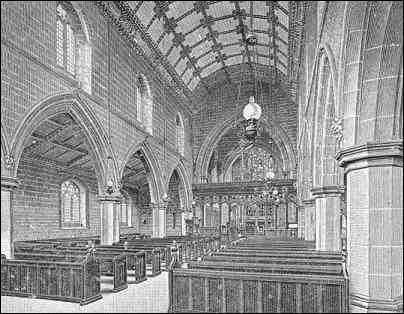Introduction:
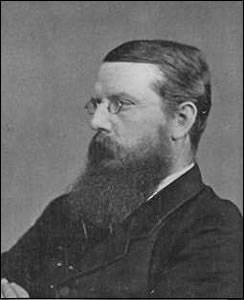
Visitors to the Church often enthuse about the wonderful colouring in our east windows. The colours are at their best in early sunshine during the Communion Service. Those of us who take it for granted should pause for a moment to think what a drab world it would be without the green of trees, the deep blue of sea or sky and the rich red of flowers or sunsets.
The window shows our Lord in Majesty “with clouds descending”, surrounded by angels, some of whom are parting the clouds and with “the earth His footstool”. When the Church was first built the hangings in the chancel were chosen to match the colours of the window – a central one in terra-cotta and gold with deep blue ones designed by William Morris on either side. These in turn were matched by the Turkey carpet which is still in use.
The building was given to the village by John Gretton of Bladon (pictured right), this being a case of ‘local boy makes good’ as the original family home was a farm in Beach Lane in Stretton, at the point of the present Burton Bypass Flyover. John Gretton had always taken an interest in the upkeep of the original church and eventually there came a time when, asked about more repairs, he suggested a new church built with ‘nothing but the best’.
Some of the land was donated by the Marquis of Anglesey, who owned all the village at that time, but John Gretton chose the site himself and insisted that the building should be set exactly east-west, with no compromise as is often required on town sites. It was said at the time that he took a “deep interest” in the work, much of which was supervised by his son, John Gretton MP.
The building was designed by two eminent Victorian architects – Somers Clarke, Surveyor to St. Paul’s Cathedral and, (when he retired to Egypt due to ill health), John Thomas Micklethwaite, Surveyor to Westminster Abbey.
The building has brick footings, which was usual around that time, above which the outside is of sandstone from Stanton, Derbyshire, and the inside of red sandstone from Runcorn. The actual builder was Mr T Halliday of Stamford.
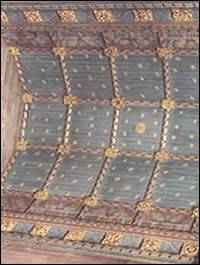
Nearly all the major furnishings date from the same time and harmonise well with one another. Micklethwaite always said that the architect who designed the building should be involved in furnishing it and an obituary article in the Architectural Review in December 1906 comments: “A Church near Burton, where expense was not stinted, he thought one of his best”. The “expense” came to £30,000, a huge sum at that time.
The church is designed in the 13th century style, with an elaborately carved rood screen separating the choir, (traditionally belonging to monks), from the body of the Church which always belonged to the congregation. The general impression is of a very light, airy building and the woodwork, of good English oak, adds to this. The original oil lamps, (see picture of old lighting), were replaced by electric lights when these became generally available and were changed again early in 1977 when the stronger lights for reading were much appreciated. Extra lights to show off the altar and decorated ceilings, were installed at the same time.

The Font
The font was traditionally placed near the main enterance of the church, symbolising that entry to the Church family is by baptism. At St. Mary’s it is set between the north and south doors and stands on a flight of circular steps.
The steps and the font itself are made of Frosterley marble from Weardale, near Durham. This has been used since medieval times as a decorative material in churches and can be found in several catherdrals. It contains many fossils which are usually a source of great wonder when first pointed out to our visitors – especially children.
The canopy over the font is octagonal in shape, for in the medieval church the figure ‘8’ represented rebirth and resurrection. The eight recesses contain figures connected with baptism or covenants between God and man – Adam, Moses, Jesus Christ, St. John the Baptist, Phillip the Deacon and St. Paul. Adam faces west, the direction used by early Christians when reciting the creed, while Jesus faces east. This was said at the time to be ‘a truly eloquent comparison’.
Under the figures are the words ‘It is better to trust in the Lord than to put any confidence in man.’ It is interesting to note that the work Lord is positioned under the figure of Jesus, ‘man’ is written under Adam and ‘confidence’ comes under Abraham, a man of faith.
The Nave, Chancel and Sanctuary
Stand with your back to the font, looking east, and notice the ceiling. The Magnificat, (The Song of Mary), runs along the edges of the ceiling in the nave, with a coloured canopy of “sun, moon and stars in heaven” at the chancel steps. The ceiling in the chancel is more elaborate than in the nave, with the motif of the heavens repeated in the sanctuary, with the addition of an angel choir.
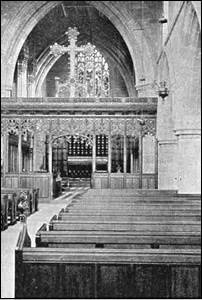
The rood screen, separating the two areas, is elaborately carved with pomegranates. New life in Jesus and the unity of the church are both represented by the many seeds in one fruit. There are also thirteen different bosses, said to be ancient designs, and seven shields which show the emblems of our Lord’s passion – including the dice which were ‘thrown’ for his robe! ‘Rood’ is an Anglo-Saxon word meaning ‘tree’ and traditionally rood screens carry a representation of Christ on the Cross, (‘the tree’), with the Virgin Mary and St. John, one on each side. Here we have an empty cross, (symbolising the resurrection of Jesus), and across the centre of the screen the words: ‘So God Loved The World That He Gave His Only Begotten Son’.
The woodcarving was all beautifully done by Mr Knox of Kensington, London. The windows in the sanctuary, including the East Window already mentioned, were all designed by Sir William Richmond who also designed the mosaics in St. Paul’s Cathedral. The two side windows show three apostles in each – St. Andrew, St. Peter and St. James on the south; St. Philip, St. Paul and St. Thomas on the north.
The roof in the sanctuary repeats the sun, moon and stars motif, with angels on either side. Those at the ends hold musical instruments and in the centre three more hold scrolls reading, “Holy, Holy, Holy, Lord God of Hosts” and “Heaven and Earth are full of thy Glory”. The carving on the screens and the words on the roof, therefore, all come from the service of Holy Communion.
In the sanctuary the carving on the south wall, (described as “an interesting chronogram”), gives the year of the consecration of the church for those who know how to read it! Normally translated as “Glory to God in the Highest, on earth peace, goodwill towards men”, the Latin reads:
“NVNC GLORIA IN EXCELSIS DEO ET IN TERRA PAX HOMINIBVS BONAE VOLVNTATIS”
To find the date of the consecration, convert the large bold letters, (the ‘Roman Numerals‘), into the numbers we normally use, (“Base 10“), and then add them up as follows:
5, 100, 50, 1, 1, 10, 100, 50, 1, 500, 1, 10, 1000, 1, 1, 5, 5, 50, 5. 1 = 1897
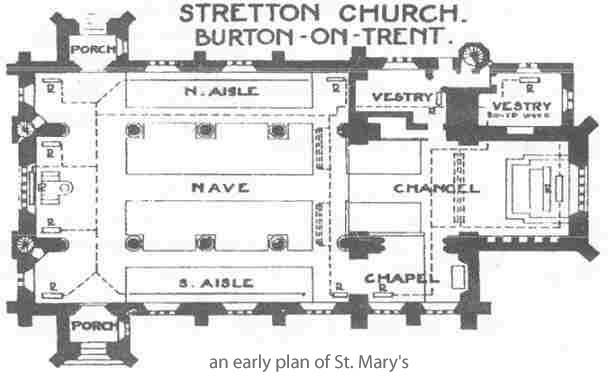
Of course, the main use of the sanctuary was always to house the altar. Here, the low reredos is made of marble and alabaster and various altar frontals have been given to the church in fairly recent times. The white one, which is often used for church festivals, was given by the Mothers’ Union in 1984, after being designed by one of the members and made up in the village.
Part of the Centenary planning was to repair and return to use the original church hangings. One, of cream silk brocade, is decorated with gold-work and spangles, (the fore-runners of our sequins), and has already been in use. A lovely frontal of rust coloured stamped velvet has also been repaired. It is accompanied by a rust super-frontal with gold-work lettering reading:
“We praise Thee O God, we acknowledge Thee to be the Lord”.
The Side Chapel
(sometimes called the Lady Chapel)
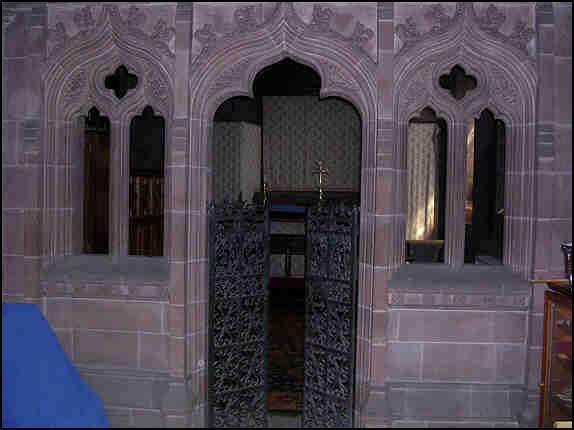
The altar here has a frontal given in memory of a parishioner who died tragically. The colours of this universal frontal were found to clash with those of the Turkey carpet so the carpet was moved into the main chapel and a plain carpet was provided in front of the altar.
The windows, which were put in some time after the consecration, represent Jesus ascending into heaven from the Mount of Olives and the scene in the upper room in Jerusalem, “when the day of Pentecost was fully come”.
At the time of writing the chapel also contains, beside the altar rail, a prayer desk and a wooden lectern which has the figure 1897 entwined in the carving.

The console of the organ is fixed here too; the soft stops are very sweet while a great volume of sound is produced from the full organ. The instrument itself was described by a previous organist as being:
“A very fine organ, built by William Hill and Son of London, the heavy pipes being brought to Stretton by canal.
It was built in 1897 during a period when organs through the country were being updated to include the latest techniques and tonal qualities”.
The stone screen, separating the chapel from the south aisle, was carved by Mr Bridgeman of the famous firm from Lichfield.
Windows

The coloured windows in the main part of the church were all put in at various times since the consecration and most subjects are easily identifiable. The middle window in the south aisle is the memorial window. Immediately below it is a brass plaque giving the names of the men who fell in the First World War, while a smaller plaque gives the names of those who died in the Second World War. In those days, the name of the parish was ‘St. Mary’s , Stretton-cum-Wetmoor’; Wetmoor being a hamlet reached most easily by a field path now virtually lost under the ‘Princess Way’ road.
The small window in the refreshment area, depicting Simeon and Anna recognising the baby Jesus as the Messiah, was given by the parishioners in memory of Prebendary John Edwards, who was Vicar of Stretton from 1890 to 1940.
Gifts to Church
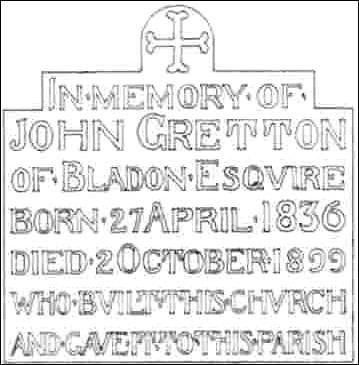
At the east end of the north aisle is a tapestry picture of the last supper, embroidered by a parishioner in the 1980’s. This is only one of many gifts over the years, including the embroidered kneelers which are continually increasing in numbers.
Other gifts include a paten, which was presented by the family of “Jabez Plinstone who was for many years organ blower and sideman”; the processional cross, given by a parishioner in memory of her parents and brother; as well as the book shelves near the south door, made by a parishioner.
More recent gifts include a nave altar, credence table and prayer desk, given in memory of a church warden of many years; a loud speaker system incorporating a “Loop” system for use by those with hearing aids, an overhead screen and projector, a mobile bookcase for hymnbooks and a wooden lectern for use when giving talks and leading services. More recently has followed much voluntary labour by the provision of a toilet and refreshment area. Special offerings have also provided for an electronic piano and speaker system control panel, the latter again being installed by voluntary labour.
As Micklewaite thought vestries “ought to be much larger than they usually are”, it has been possible to convert those here at Stretton into a Parish Office and a comfortable Prayer Room where meetings and many other activities are held.
The memorial stones now round the walls of the Parish Office were removed from the old church. On the right of this page is an example of one of those stones.
Outside the Church
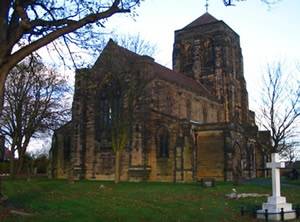
Outside the north door you will notice the stone figure of St. Chad in a niche over the door. (St. Chad brought Christianity to Lichfield and the surrounding areas in the seventh century.) Turn right and walk round the church; you may be able to tell that the original, high down-spouts are decorated with the mitre, chalice and crown, the royal monogram (VR) and also AL, (Augustus Lichfield), as well as JE, (John Edwards), and JG (John Gretton). Outside the tower is a water tap, “supplied for those who wish to keep alive the memory of the departed by placing floral tributes on their graves”. It was a matter of pride that “Lichfield water” was laid on here and in the vicar’s vestry from the time the church was built.
When the church was first built the tower housed three bells, cast by Mears and Stainbank, Whitechapel. It was always hoped to have a peal of eight bells and, although this has not been possible, we do now have six. In 1960 the three bells were melted down and, with donations from several wealthy parishioners, this enabled the church to have six bells cast by J Taylor’s foundry at Loughborough. These were rehung and consecrated by Bishop Stretton Reeve in October of that year. A plaque to this effect can be seen on the door at the entrance to the bell tower steps.
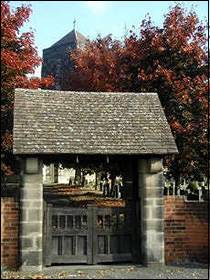
Rounding the church, we come to a grass lawn under the south wall which, some years ago was planted with several hundred daffodil bulbs from the Isles of Scilly. These are a picture to look at in the spring. More daffodils may be seen in the churchyard plus snowdrops and crocus, many of which were planted after the levelling of the ground in 1977.
Over the south door is a niche containing a statue of the Virgin Mary. From this door a path leads to the lych gate. Originally lych gates provided a resting place for coffin bearers who may have had to walk miles through the countryside carrying a coffin on their shoulders and so the gates were placed at the main entrance to the church.
The gate was originally placed on the site of the entrance to the previous church, near the cross-roads but, due to increasing traffic, it was decided that it would be safer at the Hillfield Lane entrance.
The path from Hillfield Lane originally ran under an avenue of lime trees, but these eventually became diseased and dangerous and were felled in 1978.
At a public meeting it was decided that they should be replaced with scarlet maple and people were invited to “donate” a tree. So many people took part in this scheme that, as well as scarlet maple, there were Norwegian Maple and Silver Birch planted in other areas of the churchyard. A beech tree (golden-leaved in Autumn) was planted to commemorate the golden wedding of Queen Elizabeth II and a lime tree to commemorate the centenary of the church.
Trees dating from early times include a magnificent horse chestnut near the north door, a beautiful lime tree under which is the last resting place of a member of an important gypsy family and a yew tree which is decorated by the Parish Council each Christmas. The Parish Council have also provided flood lighting for the Church, which was used for the first time to celebrate the Harvest Festival in 1988 and proved to be most spectacular.
A large cross mounted on stone steps stands in the courtyard to mark the place where the altar of the first church of Stretton stood. This, together with the inscription on it, is shown in the pictures below:
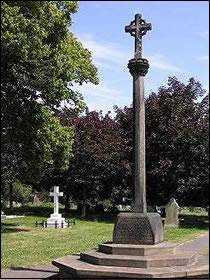 | 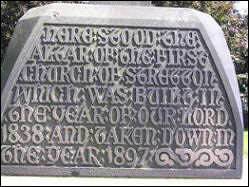 |
Church history before 1897
Before the year 1838 the few people who then lived in Stretton had to walk or go by horse and cart to Burton if they wished to attend a service, at first to the Parish Church in the Market Place, but after 1824 to Holy Trinity in Horninglow Street. Later a “Chapel of ease” was built in Stretton to make it easier for people to attend services.
The land was given to the village by the Marquis of Anglesey, (who owned all the village at that time), and many of the wealthier people from surrounding areas subscribed to the building fund, including Mr Fenny of Bladon Castle, several members of the Thornewill family from Dove Cliff, the Misses Moor from Appleby, Lady Vernon of Sudbury, Sir Oswald Mosely of Rolleston, Mrs Wedgewood of Etruria, Mr Perks of Sinai Park, many of the local brewing families and a surprising number of other people from all over England!
The chapel was built under the direction of the Rev. Peter French, Vicar of Holy Trinity Burton, whose son became Bishop of Lahore, India. The Rev. Peter French laid the first stone in 1837 and preached the first sermon on the appropriate text Isaiah Chapter 56, Verse 7.
The first appointed minister to the chapel was the Rev. William Stoddart, the first clerk Edwin Bullock and the first wardens Christopher Cotton and William Gretton, the last three being from three old-established Stretton families. A Sunday School was started very quickly, at first held in a farmhouse but later in a room where the caretaker was William Hodson – a member of another old Stretton family. The first Sunday School teachers were headed by Miss Thornewill of Dove Cliff and the chalice and paten were presented to the chapel by other members of the family. The paten, which is still in regular use at the time of writing, carried the inscription:
“Presented to the chapel of Stretton in the parish of Burton on Trent by the family of Thomas Thornewill Esq., of Dove Cliff, A.D. 1838”
The Rev. Peter French, Perpetual Curate
Christopher Cotton }
William Gretton } Chapel Wardens
Although it appears that services were held in the chapel from sometime in 1838, it was not actually consecrated until 8 October 1842 and, as the Bishop of Lichfield and Coventry was ill at that time, the consecration was carried out by the Bishop of Hereford. The following day, (Sunday), the chapel was dedicated to St. Mary.
The Bishop of Lichfield was later to say that the building had the smallest Holy Table that he had ever seen. The building itself was lit by oil lamps, heated by a stove at the back of the church and had box pews which were “rented” by the various local families. There was a small vestry at the east end and a gallery at the west end which at first contained a barrel organ with which to accompany the chants and hymns, but this was later replaced by a pipe organ. The choir sat in the gallery to be near the organ. At the west end also was a small turret housing a bell – the “five-minute” or “call” bell of the present church.
In 1873 Stretton became a separate parish, which is why the Rev. Charles Rock-West is described by older members of the congregation as “the first vicar”, even though he died before the present church was built. He was succeeded by Prebendary John Edwards, who continued as vicar in the new church for over 40 years. Both these incumbents are buried in Stretton Churchyard.
List of Incumbents
(After stretton became seperate parish)
1837: 1838: 1842: 1873: 1873 – 1890: 1897: 1890 – 1940: 1941 – 1950: 1950 – 1958: 1958 – 1964: 1965 – 1969: 1969 – 1975: 1975 – 1993: 1994 – 2004: 2007 – 2016: 2016 – 2024 Presently in vacancy | First stone laid for the first chapel Completion of first chapel First chapel consecrated Stretton became a separate parish Charles Rock-West First chapel replaced by existing church Prebendary John Edwards James Francis Wilson Francis S. L. Ramsden Derek Laughton Gerald Lane Malcolm N. Griffin A Robert Wayte Paul Howard Kim Thomas George Crossley |
